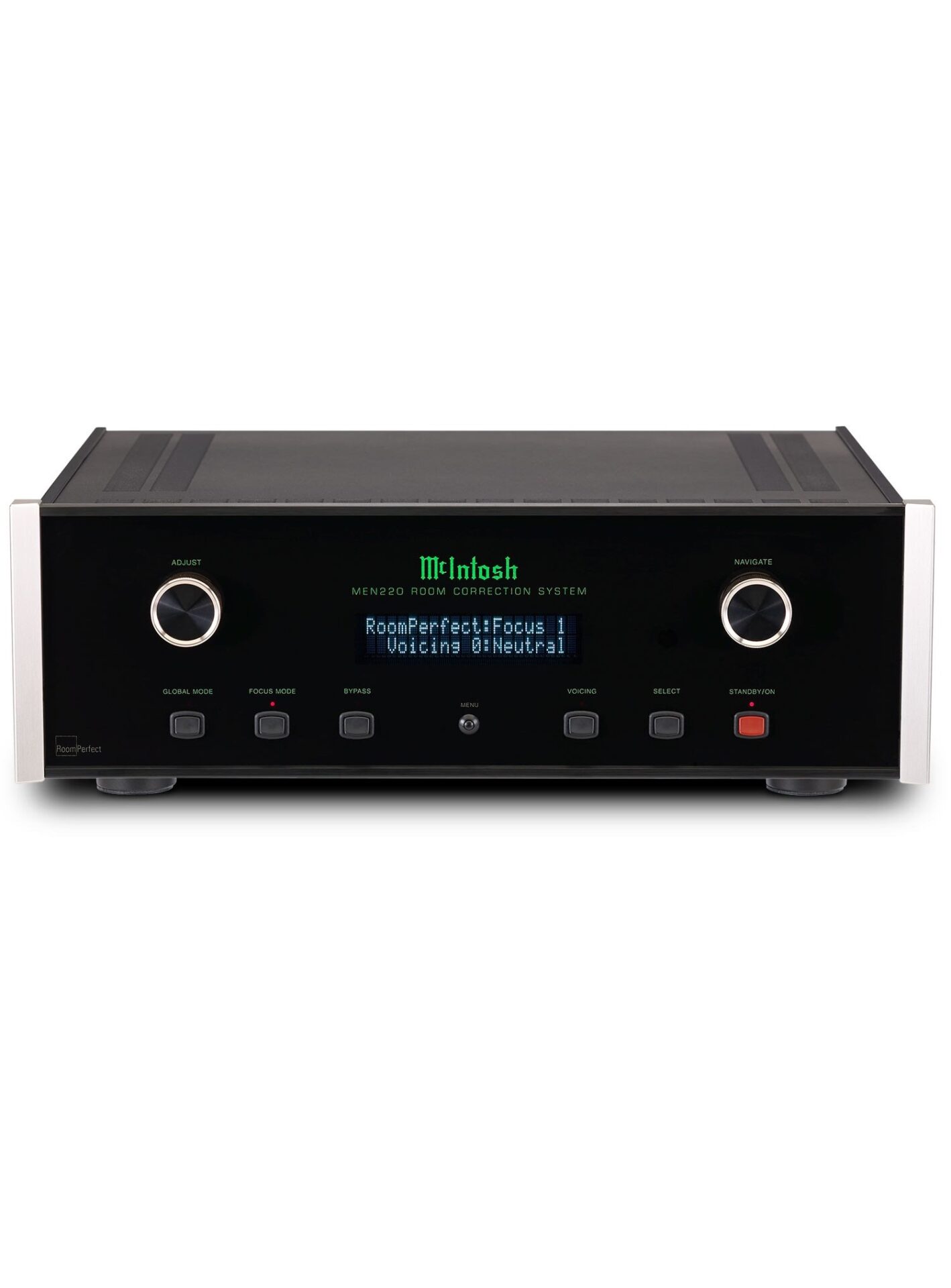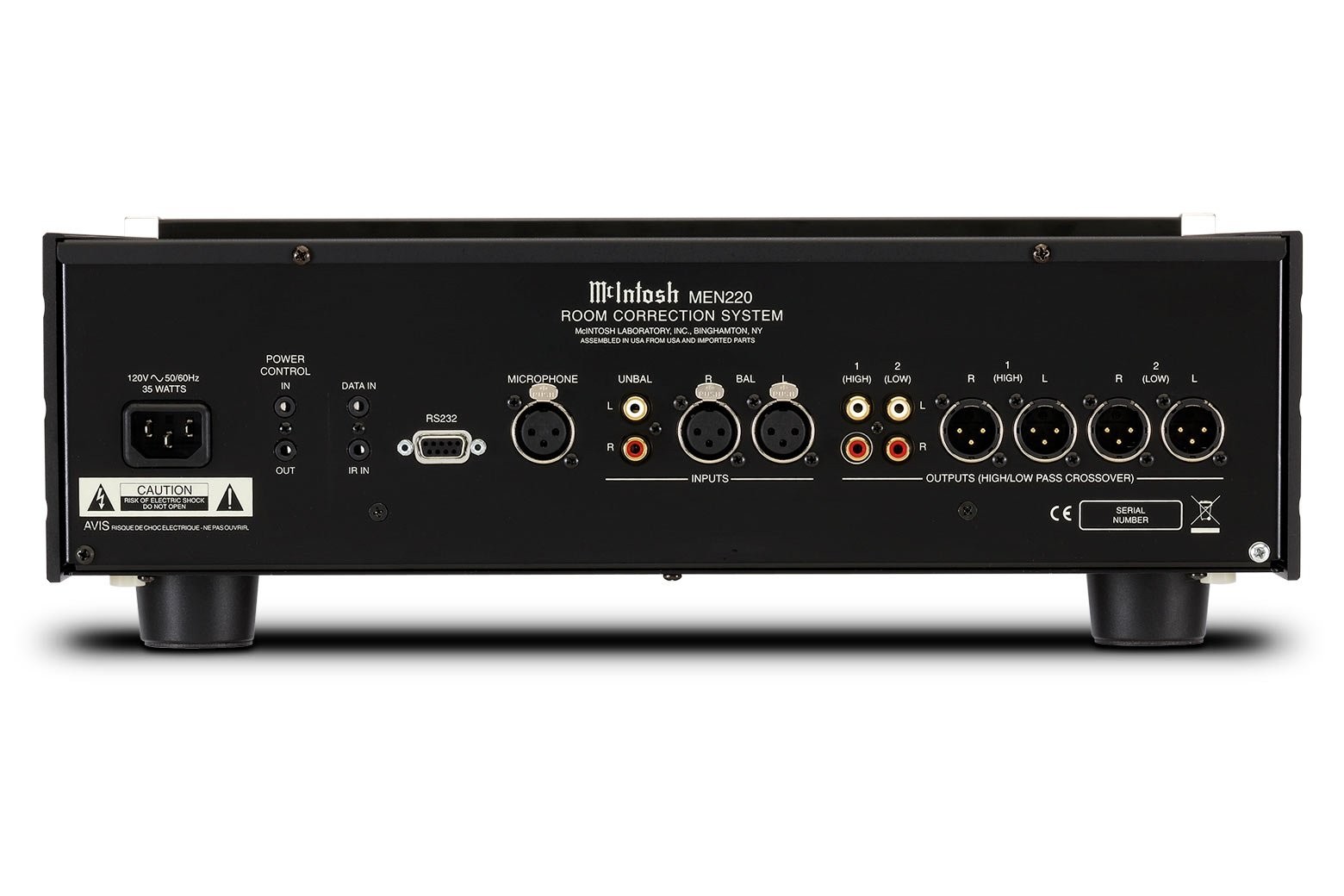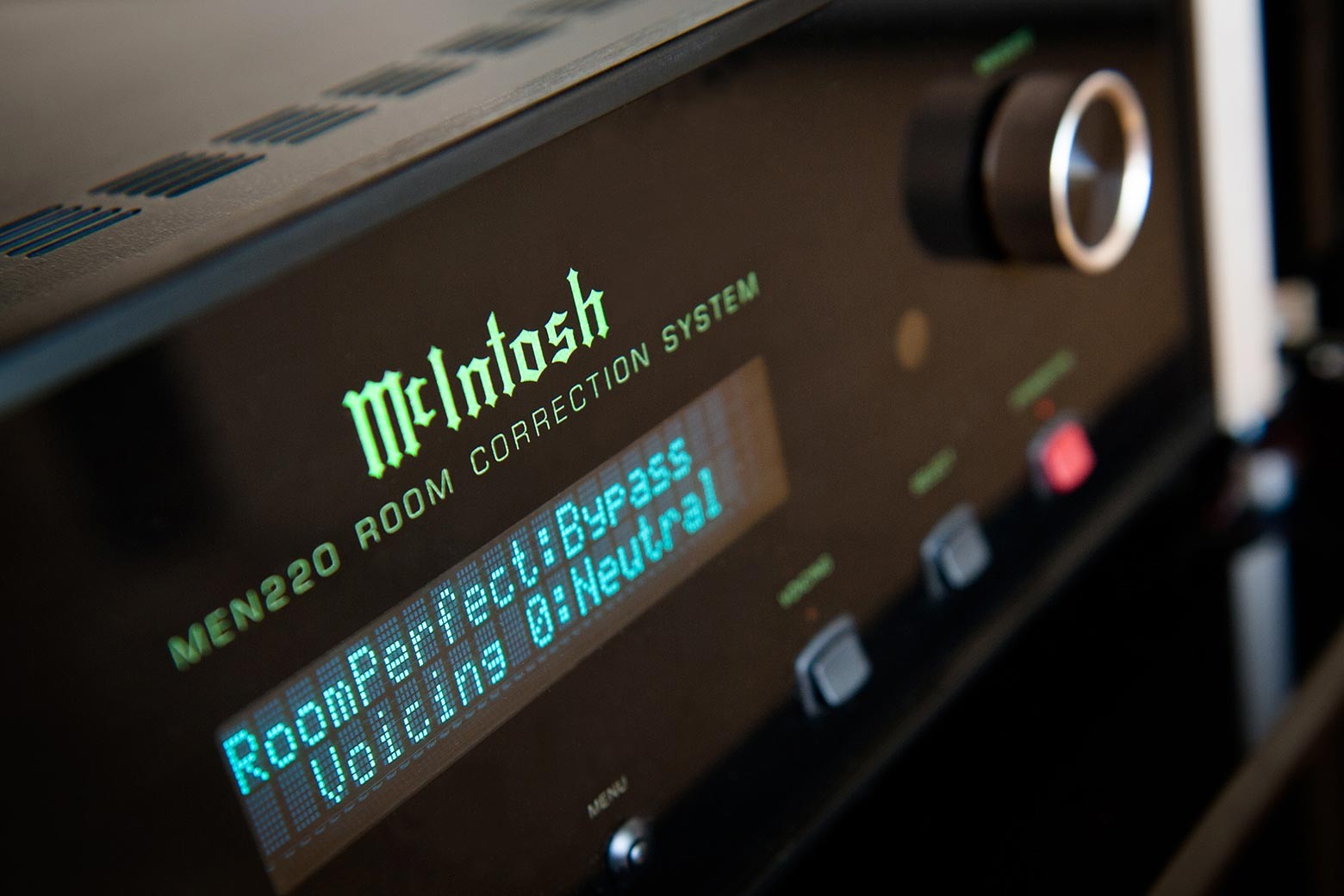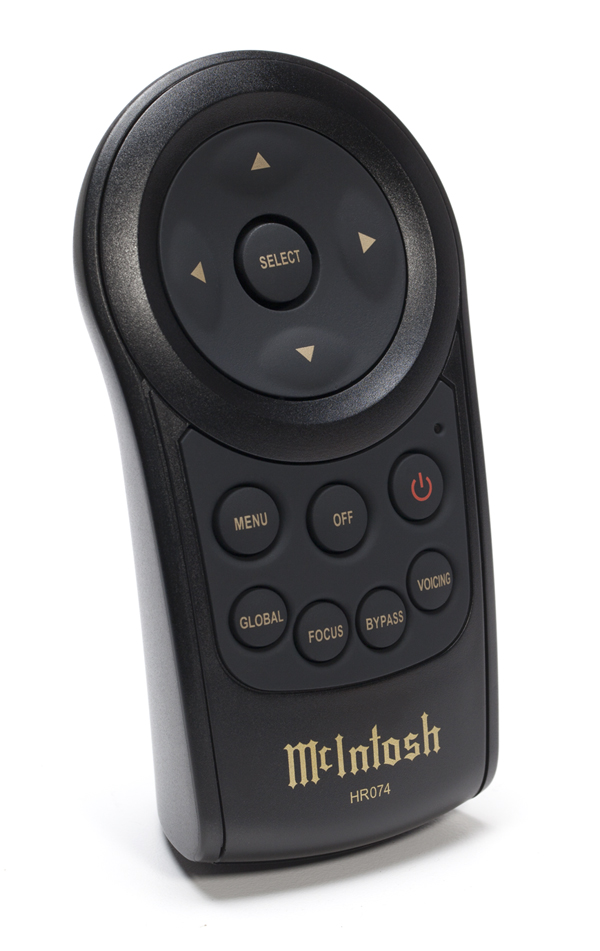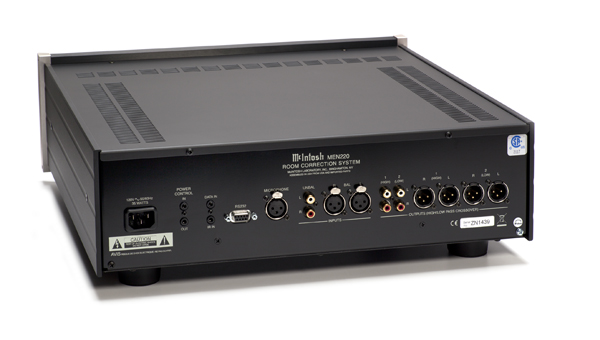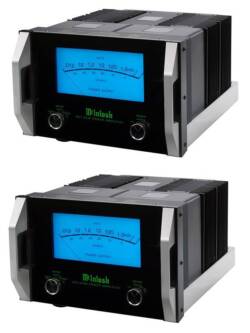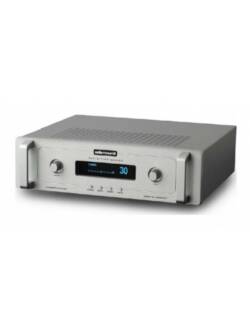McIntosh MEN220 Room Correction System
Original price was: R146,000.00.R62,000.00Current price is: R62,000.00.
McIntosh MEN 220Turning Water into Wine
By By TONE staff
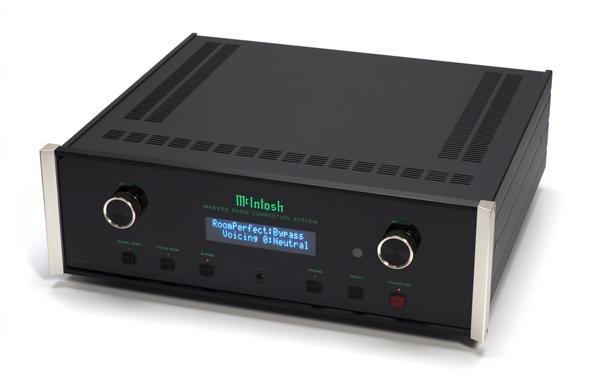 Moving speakers around your listening room to get the best possible sound can be both frustrating and fruitless. Depending on the size and type of the speakers, you could spend countless hours getting them in just the right position and, even then, the sound still might not be perfect, because the listening environment itself plays a huge role in defining that sweet spot and achieving auditory bliss.
Moving speakers around your listening room to get the best possible sound can be both frustrating and fruitless. Depending on the size and type of the speakers, you could spend countless hours getting them in just the right position and, even then, the sound still might not be perfect, because the listening environment itself plays a huge role in defining that sweet spot and achieving auditory bliss.
Room treatments are another headache. You tell yourself that your speakers will sound way better with those gigantic bass traps you’ve been lusting after, but you can only fit so much stuff into a room before friends and loved ones either intervene or nominate you to star in one of those reality shows about people who hoard things. Indeed, this process of generating the desired audio orbs down to the millimeter can quickly drive you mad. And don’t even get us started on the tape marks on the floor. As a good audiophile buddy reminds us: “The amount of blue masking tape on your listening-room floor is directly proportional to how close to a nervous breakdown you might be.”
Meet Mac’s Magic Box
Of course, a room that’s been properly treated with the speakers optimally placed is still the Holy Grail. Unfortunately, most of us don’t ever quite achieve this, so our rack of expensive gear never reaches its full potential. This is why the engineers at McIntosh Labs created the MEN220. It doesn’t use magic exactly; just a serious amount of heavy-duty science, to produce magical results, which seem all the more supernatural considering how easy it is to set up.
For the MEN220, McIntosh licensed RoomPerfect technology from Danish audio wizard Peter Lyngdorf, whose Steinway Lyngdorf music systems, which cost upwards of a couple hundred grand, utilize this proprietary room-correction software to optimize the system for any listening environment. TONE gear editor Bailey S. Barnard has written about Steinway Lyngdorf more than once in these pages and has always come away impressed. Whereas the Lyngdorf systems require a certified technician to implement the optimization software, the MEN220 allows you, the end user, to place the box between your amplifier and preamplifier, or within a processor loop if your preamplifier has one. The MEN220 works with balanced or single-ended components, so it will integrate into any system where a break between the preamplifier and power amplifier exists. Then, with a few simple measurements (okay, maybe more like 10), you’ll be on your way. But, we promise, it’s easier than it sounds—and it’s certainly less maddening than inching your speakers into the exact right spot and festooning your room with foam sound traps. Plus, it’s kind of a fun process that will make you feel like the acoustic engineer you’ve always told yourself you had the ability to be.
Once you fully install the MEN220, break out the calibrated microphone and long cord that McIntosh includes in the box. The 220’s onboard processor is equipped with internal microprocessors, which measure the reflections in your room and make corrections for the peaks and dips in frequency response. The included literature instructs you to take the first reading as close as possible to where your head is when listening to music. This will return a reading, or “room-knowledge” score, of about 75% and will substantially improve how your system interacts with your room—but the MEN220 is capable of much more.
Additional measurements, each taken from a different spot, increase the room-knowledge score. The higher the score, the more you will realize how much you were missing. Using the 220 with McIntosh’s C50 preamplifier improves things even further, thanks to the C50’s built-in graphic equalizer, which allows you to fine-tune the MEN220’s audio achievements. After a few different setups, we realized that bumping the room knowledge index above 92% eliminates the need for the onboard EQ in the C50.
We put the MEN220 through its paces in a few different environments to judge its effectiveness in a treated room, a relatively inert, non-treated room and our publisher Jeff Dorgay’s living room, which has to be one of the worst-sounding rooms anyone on our staff has experienced, with major anomalies in the bass and midrange regions. The MEN220 made a minimal difference in Jeff’s treated room with full range speakers, but in the other two environments, the 220 achieved significant gains in terms of clarity and coherence.
Wow!
When using the 220, more inner detail becomes instantly apparent. The 24-bit remaster of the Beatles’ “She Came in Through the Bathroom Window” from the Abbey Road album, startles with the level of clarity now present in this recording. The corrections made Paul’s bass line much easier to follow, gave Ringo’s percussion its own space and elevated the backup vocals that were buried in the mix. After the first of many test tracks, everyone was stunned at how much of a difference the 220 makes.
The piano hidden deep in the background of “Bang and Blame” (from the HDtracks download of the R.E.M. album Monster) now has much more airiness lingering well behind the right speaker, again exhibiting more clarity throughout the frequency range, with the bonus of additional dynamic information.
The wood block in the tune “Rich Woman,” which Robert Plant and Alison Krauss released in 2007 on their Raising Sand collaborative album, jumps out of the speakers. With an almost surreal effect, it now sounds like someone is whacking the wood block about a foot in front of the listening chair. Where was this thing in the 1970s when we all got really high listening to music?
Any thoughts of altered reality wouldn’t be complete without listening to some Doors. “Riders on the Storm” was beyond psychedelic. Again, the amount of bass resolution now on tap thanks to the 220 is stunning. The piano floats wistfully in the air, instead of just being locked in between the speakers as it was before engaging the 220.
Like an eight-year-old boy, Jeff determined not to eat what’s on his plate. He didn’t want to like the MEN220—because it’s sooo un-purist, sooo un-audiophile. (Perhaps non-20th-century audiophile is more accurate.) But with enough computer power under the hood to launch a spaceship, the 220 quickly converts the non-believers. Then staff member Jerold O’Brien’s girlfriend asked the fateful question: “We can get rid of all that stuff hanging on the walls if you have this box, right?” Like watching Wile E. Coyote scheming on how to catch the Road Runner, you could see O’Brien’s gears turning. He looked nervous and made a quick exit.
Vintage O-rama
Sure, the MEN220 did a great job with the $8,500-per-pair Dynaudio Confidence C1s, and it was spectacular with the $23,000 Sonus faber Elipsa SEs, but it was time to try something way off base. So we hauled out the circa-1970s JBL L-100 speakers. And, as crazy and as “un-audiophile” as this seems, the JBLs underwent the most miraculous transformation of all.
The L-100s are fun speakers, but their sound is decidedly vintage, even with world-class electronics powering them. After a quick set of measurements, they sounded like a pair of speakers that you’d expect to cost a lot more. The JBLs still had their limitations—the upper register is still slightly grainy and there is a touch of bass bloat that even the EQ can’t fix—but they now have natural midrange and throw a huge soundstage with some serious pinpoint imaging. Don’t believe us? Stop by our room at the Rocky Mountain Audio Fest this October (www.audiofest.net) and have a listen. We’ll be showcasing the MEN220 with the JBL-L100s in the TONEAudio “Chill Out” room.
Of course, running the 220 with the JBLs triggered a major classic-rock listening session. Christine McVie’s voice on “Songbird” from Fleetwood Mac’s Rumours floated whimsically in the air between the speakers. As easily as with any pair of audiophile-approved loudspeakers, the massive increase in system resolution enabled us to readily discern between high-resolution and standard digital files playing through the JBLs. The 220 transformed the title track of Bowie’s Young Americans (again in 24/96) into an eerily immersive experience. We could not believe this was the same pair of speakers purchased on eBay a few years ago for relatively little money. Listening to the DVD-Audio rip of the Grateful Dead’s American Beauty was much trippier, thanks to the MEN220—not an acid flashback or all the Dead karma coming back from the days when the band used McIntosh amplification for their live show. Either way, it really enhanced the listening experience.
So how close does the MEN220 bring a modest setup, with randomly placed speakers, to the megabuck systems, carefully tuned and tweaked in a room full of treatments? Much closer than any of us expected. Of course, there still is no substitute for cleaning up the acoustics with the proper treatments, but the only place the 220 comes up a little short is when playing a super high-performance analog recording. The digital processing does take that last 5% of sparkle out of the equation, but this is on a system worth a garage full of Porsches. In every other system we placed the MEN220, it delivered a stunning level of improvement.
While the magic box will not turn a $400 pair of white van speakers into a pair of $160,000 Wilson Alexandrias—even magic has its limitations—the more resolving your speakers, the more accurate of a measurement the MEN220 will be able to make. We were constantly flabbergasted by how much better an average room sounds with the MEN220 in the loop. The biggest gains are in the mid-bass range, with upper-range smoothness a close second. Cleaning up the mid-bass mess allows your speakers to deliver much cleaner midrange response with better imaging.
Reclaim Your Life
If you’re part of the lunatic (and we mean that in the best possible way) fringe of audiophelia that has a purpose-built listening room, you don’t need the MEN220. But if you are a music lover who has spent a fair amount on a system that still leaves you feeling a bit short-changed, or your speakers are still in the wrong place, nirvana is only $4,500 away. You could spend this on a few marginal tweaks that won’t change much of anything but your bank balance, but the MEN220 will definitely get your system where you’ve always wanted it to be—and it’s a hell of a lot simpler and less-maddening than moving speakers and dampening your room. So grab an MEN220 for your system and plan a vacation with all the time and stress you’re going to save.
McIntosh MEN220
MSRP: $4,500
Description
Unless noted, measurements were taken with ROOMPERFECT set to “Bypass Mode” and voicing set to “Neutral”.
- FREQUENCY RESPONSE: +0, -0.5dB from 20Hz to 20,000Hz
- TOTAL HARMONIC DISTORTION: 0.002% from 20Hz to 20,000Hz
- MAXIMUM INPUT VOLTAGE: 4.5V Unbalanced and Balanced (Preamp-Power Amp), 2.25V Unbalanced and Balanced (Processor Loop)
- MAXIMUM OUTPUT VOLTAGE: 4.5V Unbalanced and Balanced (Preamp-Power Amp), 2.25V Unbalanced and Balanced (Processor Loop)
- SIGNAL TO NOISE RATIO (A-WEIGHTED): 100dB
- INPUT IMPEDANCE: 10K ohms Unbalanced and Balanced
- VOLTAGE GAIN: 0dB
- OUTPUT IMPEDANCE: 50 ohms
- CROSSOVER FILTER TYPES, ORDER AND SLOPE: Butterworth, 1st order, 6 dB/octave / Butterworth, 2nd order, 12 dB/octave / Butterworth, 4th order, 24 dB/octave / Linkwitz-Riley, 2nd order, 12 dB/octave / Linkwitz-Riley, 4th order, 24 dB/octave / Linkwitz-Riley, 8th order, 48 dB/octave
- DIMENSIONS (W X H X D): 17-1/2″ (44.45cm) x 6″ (15.24cm) x 18″ (45.72cm) (including front panel, knobs and cables)
- WEIGHT: 25.5 lbs (11.6 kg)
- SHIPPING WEIGHT: 41.9 lbs (19 kg)
The MEN220 delivers a potent suite of Room Correction, Custom-EQ and 2-Way Crossover capabilities in one easy-to-use stereo component. While any single feature of the MEN220 has the power to optimize the sonic characteristics of the highest quality audio systems, combining all the features can reveal a level of clarity and resolution unattainable by any other means.
“I have never heard my speakers sound so wonderful!” – Michael (customer review)
Full system control and PC link are provided via RS232 while McIntosh data, power control and IR inputs offer additional remote control flexibility. Both single-ended and balanced connections are supported; a hand-held, IR remote control is included. Contact your local dealer to learn more.
